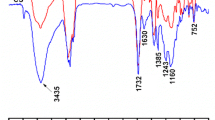Abstract
The coalescence of latex particles is investigated through small-angle neutron scattering and electron microscopy. The particles are made of a soft polymeric core protected by a hydrophilic membrane, and they are dispersed in water. This dispersion is spread on a substrate, and water is removed to form a dry film. As the membranes of neighboring particles come into contact, they may break up to allow fusion of the particle cores. This is found to occur when the membranes are made of short-chain surfactant molecules; then all hydrophilic material is expelled to the film surface or to large isolated lumps. Alternatively, the membranes may remain until the film is completely dry; this is found to occur when they are made of hydrophilic polymers which are grafted onto the core. Hence, the fusion of particles is controlled by the connectivity of membranes.
Similar content being viewed by others
References
Vanderhoff JW, Bradford EB, Carrington WK (1973) J Polym Sci Symp 41:155
Kast H (1985) Makromol Chem Suppl 10/11:447
Zozel A, Heckmann W, Ley G, Mächtle W (1990) Macromol Symp 35–36:423
Joanicot M, Wong K, Maquet J, Chevalier Y, Pichot C, Graillat C, Lindner P, Rios L, Cabane B (1990) Progr Colloid Polym Sci 81:175
Hahn K, Ley G, Schuller H, Oberthür R (1986) Colloid Polym Sci 264:1092
Hahn K, Ley G, Oberthür R (1988) Colloid Polym Sci 266:631
Yoo JN, Sperling LH, Glinka CJ, Klein A (1990) Macromolecules 23:3962
Pekcan Ö, Winnik MA, Croucher MD (1990) Macromolecules 23:2673
Greene BW (1973) J Colloid Interface Sci 43:449
Van den Hul HJ, Vanderhoff JW (1968) J Colloid Interface Sci 28:336
Jacrot B, (1976) Rep Progr Phys 39:911
Guinier A, Fournet G (1955) Small Angle Scattering of X rays. Wiley
Cabane B (1987) In: Zana R (ed) Surfactant Solutions: New Methods of Investigation, p 57. M. Dekker
Les équipements expérimentaux du LLB, available from LLB, CEN-Saclay, 91191 Gif sur Yvette, France
Ibel K (1976) J Appl Cryst 9:296
Pieranski P (1983) Contemp Phys 24:25
Goodwin JW, Ottewill RH, Parentich A (1980) J Phys Chem 84:1580
Monovoukas Y, Gast AP (1989) J Colloid Interface Sci 128:533
Lindner P, private communication
Ashdown S, Marcovic I, Ottewill RH, Lindner P, Oberthür RC, Rennie AC (1990) Langmuir 6:303
Lissant KJ (1966) J Colloid Interface Sci 22:462
Princen HM, Aronson MP, Moser JC (1980) J Colloid Interface Sci 75:246
Ebert G, Platz G, Rehage H (1988) Ber Bunsenges Phys Chem 92:1158
Goodwin JW, Ottewill RH, Parentich A (1990) Colloid Polym Sci 268:1131
Hachisu S, Kobayashi Y (1974) J Colloid Interface Sci 46:470
Bibette J, Roux D, Pouligny B (1992) J Phys II (France) 2:401
Note that this is not a usual contact angle: the drop does not wet the film, as can be seen by trying to spread it on a dry film made before
Zhao CL, Dobler F, Pith T, Holl Y, Lambla M (1989) J Colloid Interface Sci 128:437
However there is a rise atQ→0 in rehydrated films, indicating that the swelling is inhomogeneous
Author information
Authors and Affiliations
Additional information
This work used the neutron beams of ILL in Grenoble and LLB in Saclay
Rights and permissions
About this article
Cite this article
Chevalier, Y., Pichot, C., Graillat, C. et al. Film formation with latex particles. Colloid Polym Sci 270, 806–821 (1992). https://doi.org/10.1007/BF00776153
Received:
Accepted:
Issue Date:
DOI: https://doi.org/10.1007/BF00776153




